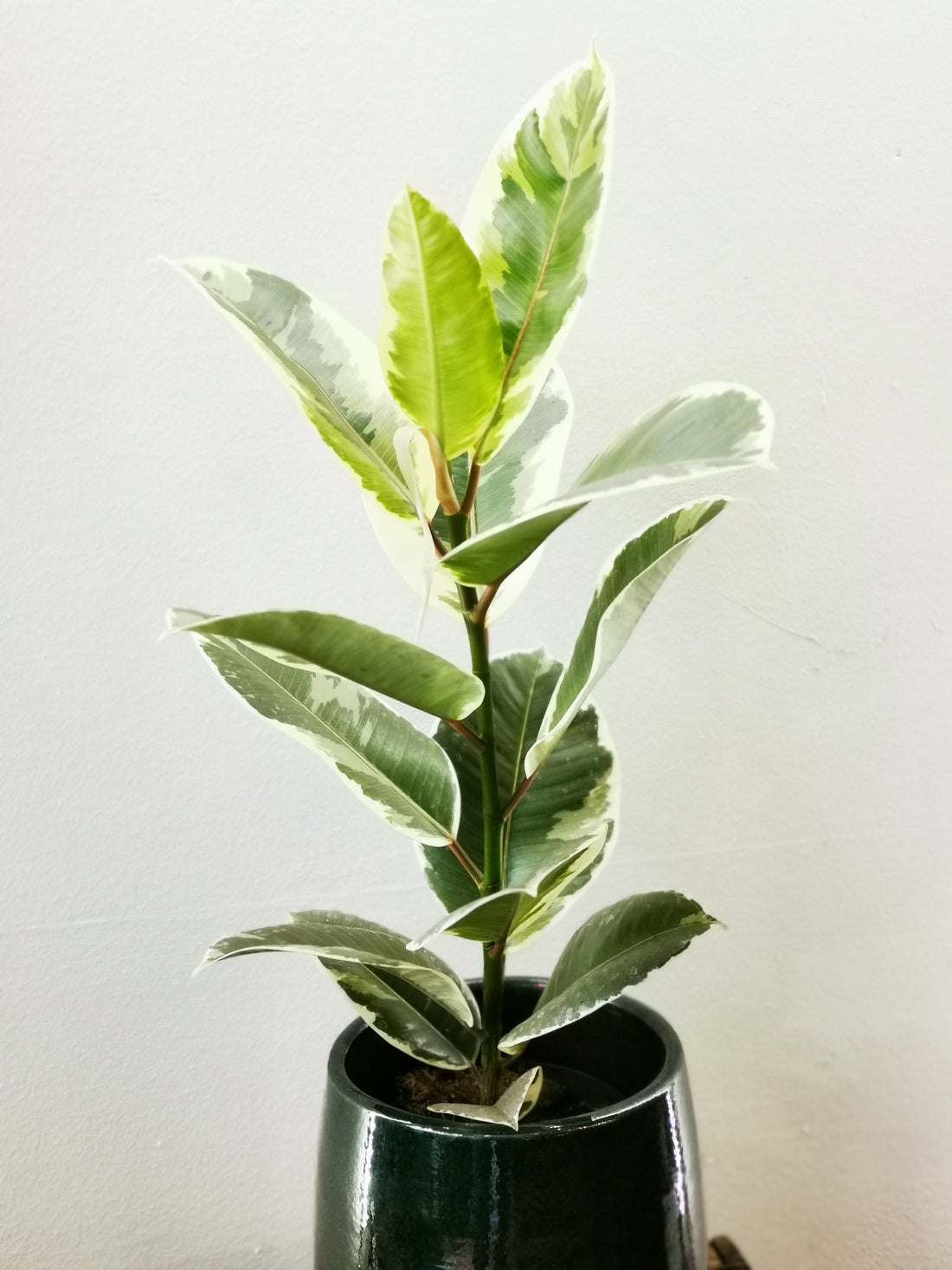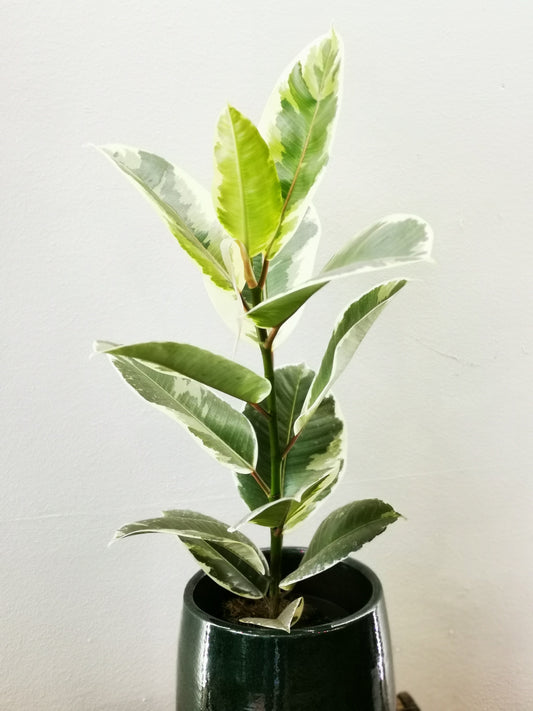
Caring for the Ficus
Share
If you’re thinking about adding a Ficus to your houseplant collection, you’ve come to the right place. In this guide, we’ll cover everything you need to know about Ficus care, from what types there are, watering to light and nutrient requirements . By the end, you’ll be an expert on all things Ficus!
The Ficus General
This most popular green houseplant originates from Africa , but also occurs in South America, Australia and Asia. The Ficus is easy to care for, can grow to 30 meters and can last a long time! At least, if you take good care of it. You can choose from different types. Something for everyone.
Different types of Ficus:
The types of Ficus that you will find with us are the following:
- Ficus Elastica Abidjan or Rubber Plant
- Ficus Elastica Robusta or Rubber Plant
- Ficus Benghalensis 'Audrey'
- Ficus Elastica 'Tineke' or Rubber Tree
- Ficus Lyrata or Fiddle Leaf/Tobacco Plant
- Ficus Microcarpa 'Ginseng'
- Ficus Benjamina
- Ficus Microcarpa
- Ficus Amstel King
- Ficus Cyathistipula
- Ficus Danielle
- Ficus Moclame
- Ficus Nitida
 There are about 750 species of Ficus. We can't list them all... If you are looking for one of these species, we can always order it for you. Contact us via email or social media.
There are about 750 species of Ficus. We can't list them all... If you are looking for one of these species, we can always order it for you. Contact us via email or social media.
Caring for the Ficus
Sunlight and location
Due to its origins in a warm climate, the Ficus likes a lot of sunlight. Therefore, place it as close as possible to a southern window, at least 5 hours per day. It is important to turn the Ficus regularly so that all its sides see the sun. Your plant can also catch a cold! Therefore, do not place it in a draft.
Discover more plants that love the sun .
How much water do you give a Ficus?
If you know that this plant comes from the rainforest, you also know that this plant likes water. Always keep the soil moist. You can check this by sticking your finger in the soil. If no soil sticks to your finger, it is time to water your friend. Normally, watering once a week is sufficient. In the summer, you can water it a bit more because it uses more energy.
Temperature for the Ficus
Ficus trees thrive best in stable room temperatures of between 20°C and 24°C during the day and slightly cooler night temperatures of 16°C to 18°C. Maintaining these temperatures is essential, especially for species such as the rubber plant (Ficus elastica) that naturally thrive in tropical climates. Protect the plant from frost and temperature fluctuations.
Is a Ficus poisonous?
Ficus are poisonous. The white sap that is released after pruning can cause irritation on contact with the skin. If pets or children eat the leaves and skin complaints occur, it is important to contact a doctor or veterinarian immediately. Discover other non-poisonous plants here .
Pruning the Ficus
It is best to prune the Ficus every autumn or when the plant becomes too large. This allows it to recover from the cold winter. The Ficus Lyrata, Pumila, Ginseng and Ficus Benjamina should be pruned in the spring. Ficus Elastica likes to be trimmed at the end of the winter. You do this with pruning shears. Remove dead, diseased and weak branches to make your plant look more youthful again. It is possible that your Ficus will 'bleed' after you have pruned it. This releases a white sap.
You can cover the wound with soil or candle wax. When you prune it, the sunlight reaches the core of the plant much better in the winter. A pruned Ficus will also use less water when leaves have been removed. Note: the white sap of the Ficus is poisonous and can irritate the skin and damage your floor!
Does my Ficus need nutrition?
A plant also needs food. With the right nutrients, the plants will get diseases less quickly and live longer. You can safely give the plant some plant food every 2 weeks.
Problems with my Ficus.
It can happen that your plant experiences some problems. But don't panic. We have listed a number of situations that can occur and how you can solve them! Is your situation not listed? Do not hesitate to contact us by email or social media.
Trouble with bugs on my Ficus
The Ficus is sensitive to mealybugs and spider mites. Mealybugs are small woolly creatures that leave a sticky substance on the plant. Spider mites are difficult to see, they look like brown or yellow brown dots. These creatures mainly cause damage to the plant. Don't panic, they are not dangerous. Spray some water on the leaves every day and wipe the leaves with a cloth. Another way with mealybugs is to dab them with a cotton swab soaked in alcohol. Don't forget the underside of the leaves and the eggs of the creatures! Also put the plant aside for a while so that your other plants are not affected by this.
My Ficus is dropping its leaves
Is it losing its beautiful leaves? What a shame! Then your plant is cold, is not getting enough sunlight or is getting too much water. Place it a little closer to the window and make sure the soil is moist! Your plant may also have a lack of nutrients. When your plant has diseases, the nutrients are reduced by this. These diseases can be: spider mites, (mealy) lice, ... When a leaf is old, it can also fall.
The leaves of my Ficus are yellow or brown.
When the Ficus shows yellow or brown leaves, this can be due to several factors. If it gets too little water, the leaves dry up and discolour. If it gets too much water, you damage its roots and your leaves turn yellow or brown. The next phase is that the leaves start to fall off. Read more about root rot here .
Another reason could be that your Ficus is not getting enough light. They need enough light to stay healthy, so with a shortage their leaves will also turn yellow or brown. If your leaves discolour due to insufficient nutrients, they can slowly change colour again if you give them the right amounts of food. Or you can start over and repot your Ficus, so your yellow and brown leaves will turn green again! Are you looking for the perfect potting soil for the Ficus?
My Ficus is falling over.
A large plant is beautiful but when it gets too big and heavy it can be annoying if it falls over. You can try putting it in a heavier pot.
Can my Ficus be placed on underfloor heating?
Yes, underfloor heating is fine, but in the winter months it is advisable to use an insulating underlay between the pot and the floor. This prevents the plant from standing directly on the floor, which can protect the plant from cold and damp conditions.






